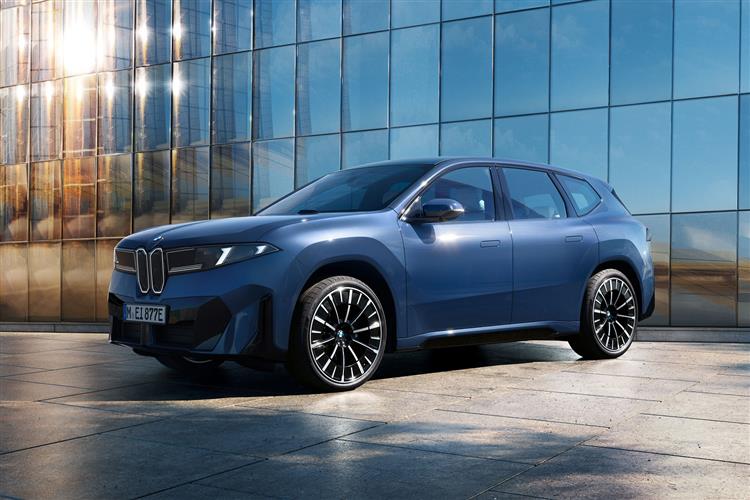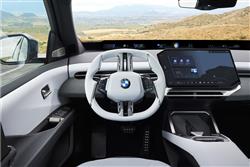This is a sample, and will stop after 30 seconds.
KLASSE IS PERMANENT (some text hidden) SECTIONED_new_bmwix3_2025_preview
By Jonathan Crouch
BMW revolutionises the mid-sized EV crossover segment with this car, the second generation iX3. Jonathan Crouch tells you everything you need to know.
Ten Second Reviewword count: 58
We're now used to car makers trying to redefine what a mid-sized electric SUV should be, but BMW second generation iX3 really does. The first of a fresh era of the Munich maker's Neue Klasse designs, it will badly frighten its premium rivals. If you're choosing at the up-market end of this segment, you simply can't ignore it.
Backgroundword count: 157
Back in 1961, BMW reinvented the way it designed and built motorcars with the original Neue Klasse models. Now, it does so again with a new electric architecture platform that will undergird its next era of development. Starting with this car, the second generation iX3. We already had five generations of BMW EV development, but this sixth one is the first not be based on a platform originally designed for combustion drive. That was the downfall of the Chinese-made MK1 iX3 that arrived in 2020, which was heavy, unremarkable and couldn't even be had with more than one motor. But that was because BMW was throwing all its resources into developing something much better - and this is it. Everything about this premium mid-sized electric SUV is different, not only from its predecessor but from just about everything else in its over-crowded sector. New standards seem to have been set here. Let's see how they stack up.
Engines and Tech Specword count: 570
You may be getting familiar with the way that heavy mid-sized EV crossovers drive by now. And if so, get ready for something a bit different here. The EV range figure - up to 500 miles from the 50 xDrive launch model - is obviously different; it makes this BMW the longest-ranging electric car currently on sale in the UK (succeeding the short-lived reign of the Mercedes CLA). But there's more than that to this car. In its own words, the Munich maker wants this iX3 to be 'more than a computer on wheels'. So it's created an electronic drive set-up with four 'super brains', including what's rather cringily called the 'Heart of Joy' - essentially a digitised automotive nervous system. These combine to create more agile, smoother and what BMW hopes are very brand-specific handling characteristics. That's quite an ask given that this iX3 is nearly 2.3-tonnes, but early reports suggest a lot has been achieved. You should certainly notice a difference in the way this car corners, helped by a near-optimum 49:51 front-to-rear weight distribution and (perhaps particularly) in the way it stops. Up to 98% of braking is handled by the electric motors, which have a regen system programmed to bring the car to a halt more smoothly than just about any other vehicle on the market, particularly if you choose the max-regen 'B' mode on the gear selector (unlike with many rivals, there are no regen paddles). Drive sound effects come via the brand's new Hyperson X soundscape, created specifically for the Neue Klasse. We mentioned the 50 xDrive initial focus variant, which uses a 108kWh battery and which has twin motors developing a total of 469hp and 645Nm of torque. This translates into a 0-62mph launch time of just 4.9s en route to a very un-EV-like top speed of 130mph. A single motor rear-driven 40 model will follow, whose lighter weight boosts EV range to over 600 miles. Either way, the driver set-up is straightforward; no start button - you just push the gear selector into 'B' or 'D' and ease away. Most of the time, you'll be in one of the three main drive modes - 'Sport', 'Efficient' or 'Silent', plus there's a 'Personal' mode that's configurable, offering bespoke adjustment of steering, drivetrain and regen settings. Set the regen correctly and you'll rarely ever need the brake pedal. Quite a few cars in this segment offer air suspension, but BMW has stuck with a heavily revised version of the passive steel-sprung set-up from the X3 here. Though in this case, built in is a clever hydraulic rebound stop, which is designed to iron out harshness and make the ride feel more compliant. Another thing that will impress you behind the wheel is the way the brand has integrated its 'level 2-plus' ADAS drive assist systems. These now use AI cameras to watch your movements and predict your intentions, rather than intervening blindly when you don't need them. The result is smoother and less intrusive operation, of the kind Chinese makers in particular really need to learn from, especially with things like adaptive cruise control and automated lane changing. This is helped by the four 'super brains' mentioned earlier, which provide up to 20 times more processing power than conventional control units. And the SUV basics here have also been thoroughly covered. Add the deployable towbar and this iX3 can haul along up to 2.0-tonnes.
To see the full road test text contact us on 0330 0020 227
Pictures (high res disabled)

.jpg)
|
.jpg)
|
.jpg)
| |||
.jpg)
|
.jpg)
|
.jpg)
| |||
.jpg)
|
.jpg)
|
.jpg)
| |||
.jpg)
|

|
Statistics (subset of data only)
Min |
Max |
|
Price: |
£58,755.00 (At 3 Oct 2025, xDrive50) |
£62,755.00 (At 3 Oct 2025, xDrive50) |
Max Speed (mph): |
130 (xDrive50) |
|
0-62 mph (s): |
4.9 (xDrive50) |
|
Electric WLTP-Rated Driving Range (miles): |
421 |
|
Length (mm): |
4782 |
|
Width (mm): |
1895 |
|
Height (mm): |
1635 |
|
Boot Capacity (l): |
520 |
1750 |
Power (ps): |
469 (xDrive50) |
|
Torque (lb ft): |
645 (xDrive50) |
|



